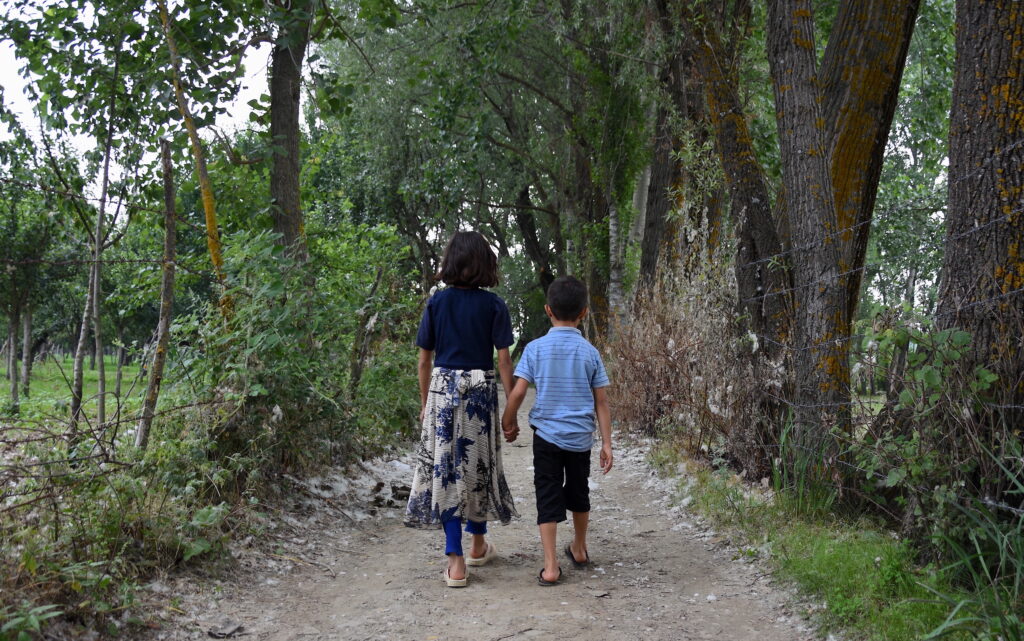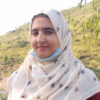A Long Road Ahead

If you missed the introduction to “A Long Road Ahead,” you can find it here.
Peace of mind is a long road ahead in the valley of mourners
Peace of mind is a long road ahead in the valley of martyrs
Where does this peace of mind come from? I often ask myself
Does it come from the skies apart, or does it come from the angels themselves?
Does it exist in the dominant regimes of the materialistic world, or does it exist in the self-determined nations of the world?
Peace of mind exists in the lap of my mother, the warmth of eternal love
But what happens when they drag you from that warmth?
Does peace of mind still exist? I ask myself
My mother says, “Ssshhhhhh, aadam bastan andar chu sir!
[1]
[1]
In Kashmiri, this saying means “humans are a makeup of mysteries.”
Peace is there where the soul is, hamin ast, even if it is dead!”
[2]
[2]
Hamin ast is a Persian saying meaning “it is here.” The phrase is attributed to 13th-century Sufi saint and poet Amir Khusrau, who said about the Valley of Kashmir: “Gar firdaus, bar ruhe zamin ast,/hamin asto, hamin asto, hamin ast.”/(“If there is paradise on this earth,/it is here, it is here, it is here.”) This couplet was repeated by the Emperor Jahangir when he visited Kashmir for the first time and was mesmerized by its beauty.
I ponder upon the rising instability of minds in Kashmir
Increasing year by year, month by month, week by week, day by day
Impending moment by moment, bit by bit, soul by soul, body by body, child by child
Occupation comes and seeks you, rules you, ruins you
Where do such unstable bodies find solace?
Is it in the hash found on their sacred land, or is it in the heroin from Afghanistan?
Is it in the rattling alcohol bottles of the Kalashnikovs or in the gunpowder of their rifles?
[3]
[3]
Army personnel in military camps in Kashmir often sling empty alcohol bottles on the barbed wire that rings these areas. The territory inside is understood to be of the Indian armed forces. Metaphorically, the ring of bottles also signifies the intensity of occupation and how the occupier protects themselves from Kashmiris. Kalashnikovs are visible on these army personnel all over the region. The term has become a shorthand for referring to members of the Indian army.
They drink to cope with the violence they do on our bodies
But we drink the emptiness of our existence
How long is this road ahead; is peace of mind a myth?
On an occupied body that wants to survive
Survive beneath the chinars, along the stretches of Dal
[4]
[4]
Chinar, known as bouin in Kashmiri, is a popular tree introduced by the Islamic mystic Syed Abdul Qasim Hamadani (RA) who traveled from Iran to Kashmir with Mir Sayyid Ali Hamadani (RA). The tree is believed to have been planted in 1348 in Kashmir. Standing tall, these trees have witnessed innumerable natural calamities and braved all the seasons in Kashmir with equanimity. The leaves of the chinar turn crimson in autumn, adding to the charm of this place. Poets personified chinar in their works to relate the resistance of Kashmir and its people through the ages. Dal is a famous lake located in Srinagar, the summer capital of Kashmir. Also called the Jewel in the Crown of Kashmir, this lake reflects the calmness and peace embodied by its beauty of flora and fauna, floating markets, and four chinars (a mini-island) surrounded by the lush green hills of the Zabarwan Mountains. Dal Lake signifies peace that heaven on Earth deserves.
Survive in the essence of nun chai, in the alleys of pyend
[5]
[5]
Nun chai refers to the pinkish tea made up of deep-red liquid extracted from tea leaves and boiled with salt and milk. Kashmiris start their day with nun chai, which is cherished on any occasion. Pyend in Kashmiri refers to the place outside shops where people gather and discuss day-to-day happenings—from politics to society and culture. This is an important form of social gathering in Kashmir.
In the womb of Mauj Kasheer, peace and calm.
[6]
[6]
Mauj Kasheer refers to the mother Kashmir, mostly used to show love toward the Valley of Kashmir.

































